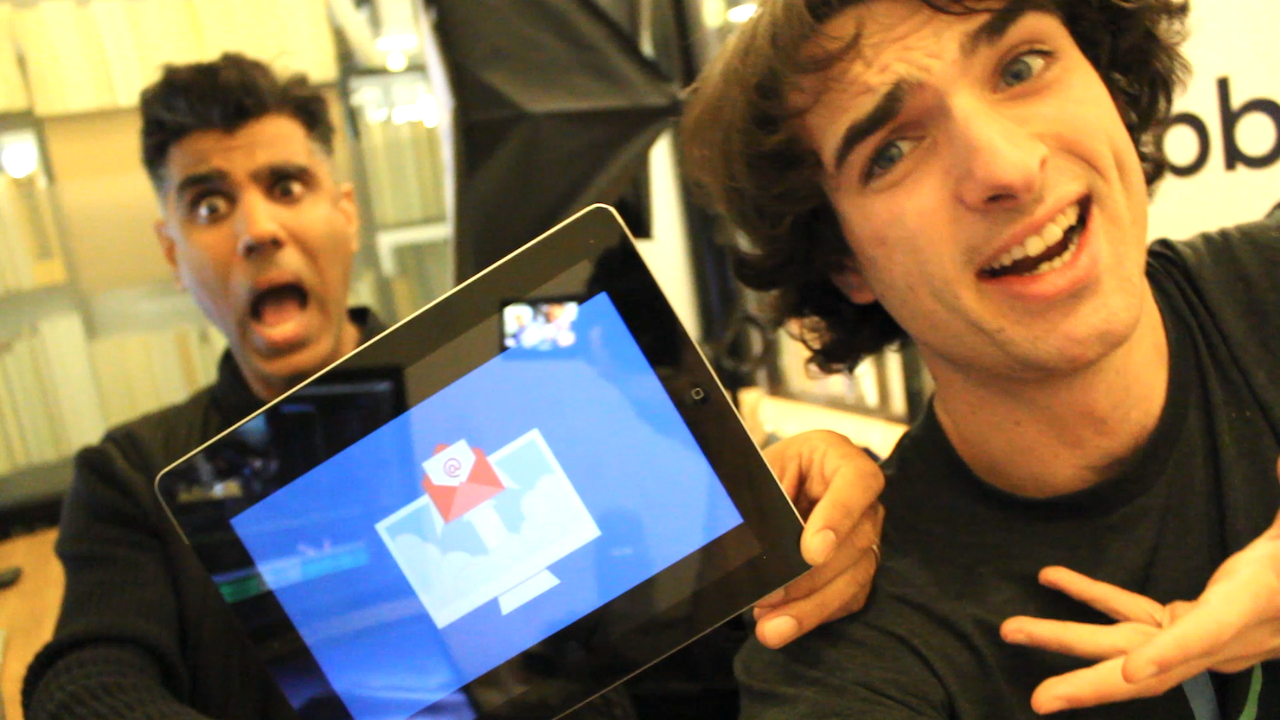A video email can be a fantastic way to connect with your audience, educate prospects, and generate more sales. No matter your business goals, you can use video emails to accelerate toward those goals.
That being said, there are some business owners, sales leaders, and others that may not know how to create or send video emails. There’s really nothing wrong with this. In our day-to-day lives, it becomes really tough to learn new business strategies—even if they can help us grow our businesses.
Because of this, I want to spend this article discussing everything you need to know about video email. This includes things like why video emails are so valuable, how you can create and use them in your daily work, and some first principles you can follow to create great video emails. At the end of this post, you will be in a great position to create video emails of your own.
Let’s get started.
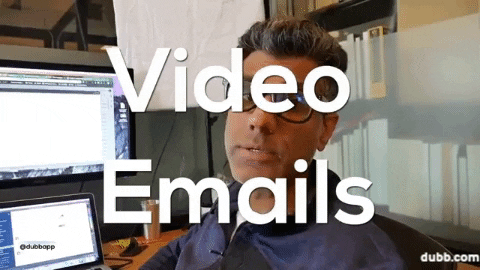
Table of Contents
Why Video Emails Are So Effective
Video Emails Combine the Best of Video and Email
Video Emails Let You Send Emails Without Attaching Them
The Advantage of Video Emails Over Zoom Meetings
Why You Want to Make Your Video Emails Actionable
A Computer, Tablet, or Mobile Device
Software to Create Video Emails
Integrating Video Into Your Business Emails: Some First Principles
Determine the Goal of Your Video Email
Include “Video” In Your Subject Line
How to Send Video Emails with Dubb
How to Send Video Emails with Gmail
How to Send Video Emails Using Outlook
How to Send Video Emails Using Another Email Application
What Are Video Emails?
To kick this guide off, I think it is important to settle on what a video email actually is. After all, if we aren’t clear on what a video email is, it will be that much harder to discuss why it is important and how you can incorporate them into your sales and marketing work.
Simply put, a video email is an electronic message that has a video in it. The title is pretty self-explanatory. With a video email, you send your video to a certain subset of people. This can be everything from one important prospect to your entire email list. The ultimate goal is for your recipients to see your email land in your inbox, watch the video that is in the email message, and then take some sort of action.
At its core, the main difference between video emails versus traditional emails is that video emails rely much less on text. Yes, there may be some text that introduces the video in that email. That being said, the crux of the video email itself is the actual video. By sending a video email, you want your recipient to click on the video and view your content.
Now, there is a key element of video emails that we must note off the bat. That is the fact that you cannot play videos inside the email message itself. In other words, there isn’t a seamless way to embed and play a video in the actual email. What you will need to do instead is insert a link to a video that is hosted on another website.
The great news is that there are plenty of awesome ways to compel your audience to click on that link and consume your video content. For instance, if you are sending a video email with Dubb, you automatically get an animated GIF inserted into the body of your email. That animated thumbnail GIF makes it extremely clear that you have sent the recipient a video and, consequently, that they should click on the GIF.
This is a much better way of sharing a video than sending a hyperlink. If you really think about it, a hyperlink can be scary or intimidating. You don’t necessarily know what you are clicking on. It can be the exact video that is promised in the body of the email. That said, it can be something entirely different. You simply don’t know unless you click on the link.
By contrast, by including an animated thumbnail GIF, you build more trust with your recipients. You make it extremely clear that they are clicking on a video. Moreover, using Dubb, you can even do things like add personalization text at the top of your animated thumbnail GIFs. This makes it even more likely that they will click on the GIF and actually watch your video. In fact, you can increase your click-through rates by up to a stunning 70%.
In the end, a video email is a unique and extremely effective way of communicating with your audience. It makes the email experience that much more exciting and engaging. Ultimately, by investing in video emails, you can build great relationships with your audience and generate more sales.

Why Video Emails Are So Effective
So with this definition of video emails in mind, let’s move on and discuss why they are so effective. There are plenty of reasons, but I believe that some of the most important reasons are below.
Video Emails Combine the Best of Video and Email
For starters, a video email is unique in that it combines some of the best parts of both video and email. To put it another way, video emails let you deliver an even more effective pitch than if you were pitching solely over video or solely over email.
Let’s start with why videos are so powerful. I think it comes down to the fact that the human brain is naturally attracted to images. According to studies, the human brain processes images a stunning 60,000 times faster than text. Moreover, 90% of information that is transmitted to the brain is visual information.
Why is this? It all comes down to our primate evolution. We depended on visual cues in order to survive. Reading text and slowly contemplating the meaning of that text paled in comparison to focusing on existential threats that were hiding somewhere dark. Because evolution takes a long, long time, we still heavily rely on these visual cues to get through life.
This deeply ingrained bias for visuals can be extremely valuable—so long as you leverage the power of video. So the fact that you are creating a video, even if it isn’t “professional,” gives you an automatic head start. Generally speaking, your audience is going to want to view video content from you. At the very least, they will click on a video out of pure curiosity. From there, it is up to you to provide value.
Now, let’s talk about email.
In today’s day and age, many salespeople and marketers focus on delivering their message or communications via social media. It makes sense. Social media platforms like Facebook and Instagram have billions of users. Considering that, you want to certainly have some presence on social media platforms.
That being said, email is a huge marketing channel that often gets overlooked. Just think about it. How many times do you check your email per day, whether it is your personal email account or professional email account?
According to one study by Adobe, respondents spent an average of 209 minutes (around three-and-a-half hours) per day checking their work email. They also spent 143 minutes (around two-and-a-half hours) checking their personal email. Combined, this resulted in almost six hours of office workers checking some sort of email every day.
This is a huge number. Whether you are sending your email to a personal or work account, you have multiple hours per day where you have your audience’s attention.
Better yet, one of the best things about video emails is that you are sending your video content straight to your recipient. Once you click send on your video email, you are directly interacting with your recipients’ inboxes. When they open their email client, they will likely see your message at the top of their inboxes. If your subject line is good enough (we’ll get to subject lines below), you are in a good starting position.
Ultimately, this combination of both video and email is a killer one. You are able to communicate in a way that we as humans prefer. Along with this, you are sending messages to places that we constantly check. What’s not to like?
Video Emails Boost Curiosity
Another key advantage of a video email is that it can boost your recipients’ curiosity. Primarily, this is because nearly all of your recipients are receiving text emails.
Granted, those text emails can be compelling in and of themselves. Take an email that promises a huge discount for your favorite product or service. In all likelihood, even if they are text-based emails, you are going to open them.
With that said, video emails can go even further in piquing your audience’s curiosity. Part of the reason is that there aren’t many video emails that are being distributed. Some may consider it a novelty. Therefore, there is a massive opportunity for business professionals like you to create video emails and send them to your target audiences.
Beyond that, video emails are so intriguing because we don’t know exactly what will be in the video before clicking it. In a text email, for instance, what you see is what you get. There really aren’t any surprises in the body of the email. Even if there are, you discover them relatively quickly. You read the email, you see what it’s all about, and you move on with your day. In reality, this may be anywhere from a few seconds to around 30 seconds.
With video, however, the game has entirely changed. While you may have some text before the video itself, your audience’s attention will be solely focused on that video. If you are using Dubb, they will see that animated GIF preview that I mentioned. Even if it is just a thumbnail with a play icon on top of it, your recipients will be much more likely to click on the image and start watching your video.
In the end, a huge part of sales and marketing is piquing your audience’s interest. By creating a video email, you are much more likely to differentiate yourself in the noisiness of your recipients’ daily lives.
Video Emails Let You Send Emails Without Attaching Them
This is a huge benefit of video emails. When I was defining “video email” above, you may have been wondering whether you could attach a video to the email itself.
Wouldn’t that solve the problem of not being able to play a video directly within the email itself?
The short answer? No.
You absolutely do not want to attach a video to an email. In all likelihood, the video that you are sending out via email is going to be a huge file. This is true even if the video is 30 seconds or one minute long. Because video files are so large, attaching them to your emails means that your email is going to get blocked. It’ll be really unfortunate if you schedule an extensive email campaign (which includes an attached video) and that email is blocked by many of your recipients’ inboxes.
Along with this, few people click on video attachments in the first place. It’s like clicking on an unknown hyperlink in the body of an email. Arguably, an attachment has a worse stigma. In your recipients’ eyes, the attachment could actually be a valuable video, but it can also be a virus. If your recipient is receiving an email from you for the first time, the odds are slim that they will click on the attachment. Even if they know you (or have even purchased your product or service), asking your audience to click on an unknown attachment is a tall task.
Video emails completely bypass this problem. Instead of attaching any type of video to an email, you can link your video to a separate webpage. As I will discuss below, that webpage (which can also be called an action page) lets your audience not only watch that video, but interact with call to action (CTA) buttons below the video. That way, you can continue the conversation after your video and make it more likely that your viewers become paying customers.
Video Emails Build Trust
Finally, one of the best qualities of video emails is that they build trust. They help you build strong relationships with your audience, whether that audience is made up of brand new prospects or loyal customers.

Video emails are so great at building trust because your audience can actually see you. Instead of reading text in that person’s voice, they can see you articulate your message. As you likely know, communication is about so much more than the words coming out of our mouths. Communication is also about tone of voice and body language. We can be saying one thing and our body language and tone of voice may be communicating something entirely different.
With text, it is essentially impossible to convey tone of voice and body language. There is really no effective way to gesture or emphasize certain words or phrases. Yes, you can include things like italics or bold text to draw your audience’s attention to something. That being said, it isn’t as effective as your audience actually seeing your body language and listening to the way that you are communicating.
With video, you get to leverage those benefits. Even if you are just sending a 30-second video email, your audience will be more likely to trust you. They get a better picture of you, your company, and what you are about. Even though it may not feel like it at the time, you are getting one step closer to establishing that deep trust that can earn you a customer for life.
So whether an audience member is at the top of your sales funnel or the bottom of your sales funnel, video will help you build trust with anyone. No matter what you are discussing in your video email, you’ll be able to leverage this important benefit.
The Advantage of Video Emails Over Zoom Meetings
At this point, you can see why video emails are so effective. They are fantastic ways to build your audience’s curiosity and build their trust in your business. Moreover, they capitalize on our preference for visuals and land in a location—our inboxes—that we check multiple times per day.
All of that said, you may be wondering whether there is a good alternative to video emails. That alternative is a Zoom meeting. Whether you are using Zoom, Microsoft Teams, or any of the alternatives, these types of tools can help us virtually meet with prospects, customers, and colleagues.
As you likely already know, Zoom has taken over our lives during Covid-19. Tools like Zoom have become so popular that some of us have developed so-called “Zoom Fatigue.” Much of the fatigue comes from the fact that we have to be on video calls for hours upon hours every day. We have to clear our schedules and ensure that we can meet with our teams at a predetermined time. While some of us are returning to the office, we are probably going to continue scheduling Zoom calls for the foreseeable future.
These scheduling pains and sheer fatigue that come with Zoom calls are some of the main reasons why you may want to consider video emails. One of the largest differences between something like a Zoom call and a video email is the fact that Zoom calls are synchronous and video emails are asynchronous.
With synchronous videos, you and your viewers need to be in the same place at the same time. With asynchronous videos, however, you can record your video at one time and have your audience watch that video on their own time.
This is a huge benefit if you want to send a video email. Zoom meetings can be terribly difficult to schedule. The larger the Zoom meeting, the tougher it is to find a time where everyone is available. It’s almost inevitable that someone will have to miss the meeting, meaning that they will need to be filled in at a later point.
With asynchronous videos (like video emails), the situation is much different. Instead, you and your audience get much more control over your free time. Rather than juggling calendars and briefing others after the meeting occurs, you can find the most optimal time in your schedules to create and watch the video. You can simply record your video, email it to your intended audience, and have them watch it whenever they want.
With video emails, you also get to avoid those annoying interruptions that may happen during the course of your standard Zoom meeting.
If you have been in a Zoom meeting with many people, there are those inevitable moments where one speaker may be interrupting another speaker. Or there may be moments where someone is speaking and there is lag. The speaker’s Internet may even die. Whatever the case may be, these hidden interruptions make the meeting less engaging and more distracting.
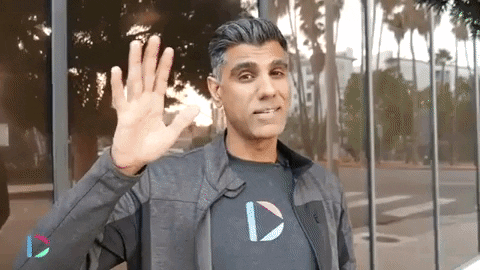
You don’t get these types of problems in video emails. The main reason is that video emails are pre-recorded. If you notice that you made a mistake or that your Internet cut out, you can simply stop the recording and start up again. Interruptions aren’t a thing since you are shooting a video that isn’t live.
Sure, Zoom meetings have their place. Synchronous video is here to stay. Nevertheless, a video email provides some massive benefits over synchronous video solutions like Zoom. Whether you are trying to communicate with a prospect, customer, or colleague, recognize that a video email may be the best way to go.
Why You Want to Make Your Video Emails Actionable
Now, let’s talk about one of the most important parts of any video email. While you don’t necessarily need this feature to create a video email itself, this feature is arguably mandatory if you are sending a video email in a business context.
That feature? The ability to make your video emails actionable.
Actionable videos are pretty self-explanatory. Essentially, they are videos (or features surrounding those videos) that convince your audience to take some type of action after watching that video. Whether that action is contacting your company or even purchasing your product or service, actionable videos can galvanize your audience.
If you think about the vast majority of video content on the Internet, a simple process occurs. The viewer stumbles onto the video, whether they are actively looking for it or whether they are following a recommendation on a site like YouTube. From there, the viewer watches the video. They may be passively watching it or more engaged. When the video concludes (or the viewer gets bored), they move onto something else.
It is in this latter part of the process where actionable videos really help. In a business context, the last thing you want is for an audience member to watch your video content, really enjoy it, and then erase it from their mind and focus on other things in their lives.
You want them to take action right now.
Actionable videos can help you with this problem. No matter what type of video content that you are creating, an actionable video makes it more likely for your audience to go from point A to point B.
So what makes an actionable video email?
I think it comes down to what you say in the video email and what accompanies the video email.
In the video itself, you want to be clear that the viewer’s experience isn’t over after the video concludes. This is why you want to include some type of CTA in your video. In all likelihood, it will be at the end of the video, but you can interspace it however you’d like. As for what your CTA actually is, it is typically a website or phone number. But yet again, the choice is up to you.
What you want to do is direct your audience to do at least something. Whether it is you actually speaking the CTA, having the CTA edited onto your screen, or both, including a CTA in this way makes your video email much more actionable. Since you are sending a video link in an email, you may also want to seriously think about including another CTA in the body of your email. While your audience may not click on it before watching your video, it is yet another chance to engage with your audience and move them down your sales and marketing funnels.
As for everything surrounding the video, I highly encourage you to take advantage of video action pages. Video action pages are specific webpages that host your video. You can think of them as the central hub for every single one of your video emails. On your video action pages, you will have the video itself along with several other things, including CTA buttons, your contact information, and more. These additional features help you better engage with the viewer and convince them to take some sort of action.
As a Dubb user, you can get a video action page for every one of your video emails. Better yet, you can customize these video action pages, making them consistent with your brand and overall messaging. It is another opportunity to showcase your brand and convince interested viewers to become customers.
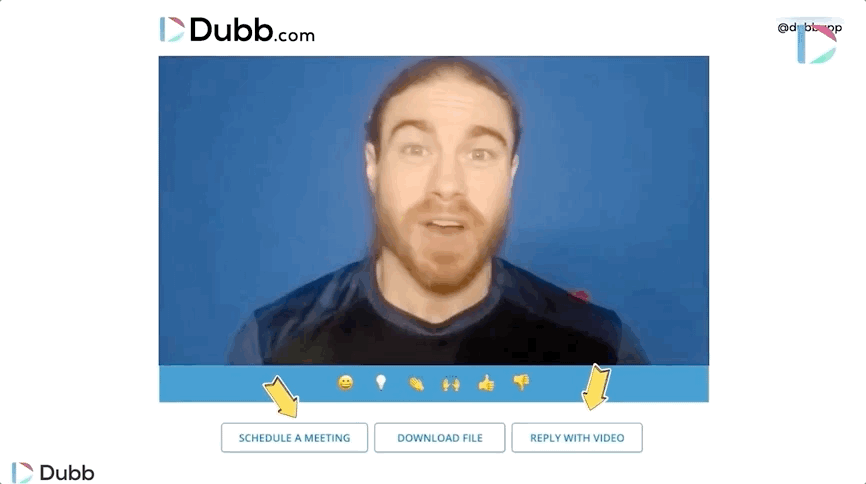
In the end, if you are sending a video email, you should make sure that you have access to a video action page. It really works. According to one study, videos on a landing page can increase conversion rates by 80%. This is obviously huge so you want to ensure that you are taking advantage of this opportunity.
Solely hosting your video on YouTube, while it may work in your personal life, isn’t the best way to build and nurture that audience relationship. Because you are creating video emails in a business context, you must make your videos actionable. Doing this is a really important part of creating the most effective video emails.
What You Need to Get Started
To this point, we have spent lots of time talking about the why of creating and sending a video email. Video emails can help you build stronger relationships with your audience and help you grow your business. If you haven’t already started sending video emails, I’d encourage you to do so.
That naturally leads to the question, however, of how to create and send video emails. At Dubb, we have been sending video emails for quite some time. We have some expertise in creating video emails that will help you accomplish your goals—whatever they are.
I want to share some first principles on how to make the best video emails. Before that, however, it’s worth our time to discuss what you’ll actually need to get started. Fortunately, you can get started very easily. There isn’t much you need to get off the ground and start making great video emails.
Mandatory Items
First, let’s discuss some of the things that you’ll absolutely need.
A Computer, Tablet, or Mobile Device
The first thing is table stakes. To create any sort of video email, you will need a device like a computer, tablet, or mobile device. Ideally, your electronic device will have a built-in camera and microphone. Nearly all do, but you may want to double check—especially if you are using an older device.
If you just want to experiment with video emails, your device’s microphone and camera will probably be enough. The goal isn’t for the equipment to stop you from creating content. Rather, if you are just starting out, you should be focused on creating any type of video email—no matter how “unprofessional” it may seem.
So if you already have a computer, tablet, or mobile device (which you likely already do), there’s no need to go out there and get a new device. It should be enough to at least get started.
Software to Create Video Emails
Next, you will need some type of software to actually create your video emails. There are plenty of different types of software that can help you with this task. Dubb, for instance, lets you easily shoot, edit, and distribute your video emails. We will talk about Dubb a bit more below, so stay tuned.
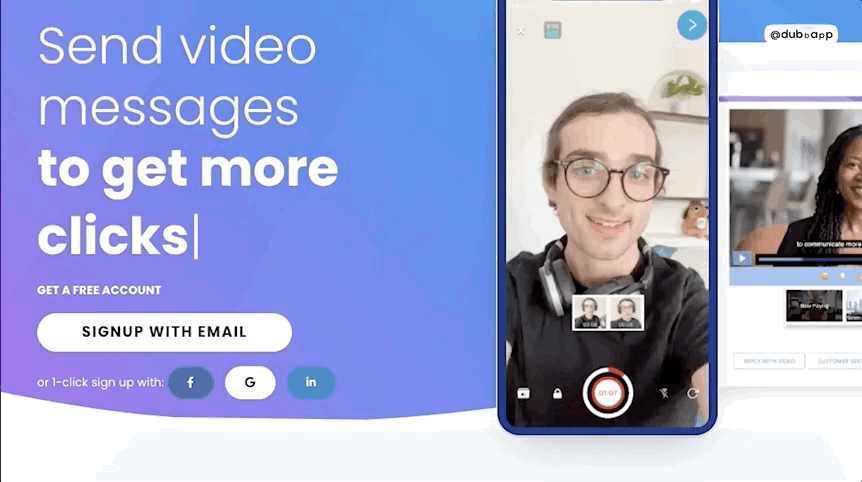
Beyond Dubb, however, you will find other pieces of software that can help you with all of these tasks. No matter what you choose, I recommend that you do your due diligence. Many of these pieces of software offer free trials, so it costs virtually nothing to get started. Take advantage of these free trials and see what they have to offer.
No matter what, you are going to need software that helps you with recording, editing, and distribution. Make sure that you have them before proceeding.
Optional Items
Really, the bare minimum that you need is an electronic device and some software. Whether you are shooting video on your mobile device, tablet, or laptop, you can use these tools to at least get started.
From here, let’s talk about some of the optional items that you can use for your video emails. While these items are optional, they can help you create even more compelling video emails. Depending on your budget, you may want to consider investing in one (or several) of these items.
An External Microphone
An external microphone can be a great investment for your video emails.
Like I said above, your device will almost certainly include some sort of microphone. Even though you can use this microphone to get started, a separate microphone can make your audio much clearer. This is true whether you are creating a video email in your office or when you are on the go.
The reality is that clear audio can really improve any type of video. It makes it more engaging, thereby making it more likely that your audience will pay close attention to what you are saying. Even if you aren’t a huge audiophile, you can probably tell the difference between a good microphone and a bad microphone.
So what microphone to purchase? Ultimately, there are plenty of high-quality microphones out there that likely meet your budget. While I’m not going to make specific recommendations, I really like lavalier microphones. These are microphones that provide great audio quality and you can take them outside your home or office. Wherever you are, you can attach your lavalier microphone to yourself (or another person) and get solid audio quality for your video email.
Whatever you choose, make sure you are doing your research. Whatever you choose, investing in a high-quality microphone can not only help you with your video emails, but it can help you with any type of video content that you create.
A Separate Camera
Like an external microphone, a separate camera isn’t a hard and fast requirement. After all, you likely have a pretty good camera on your laptop, tablet, or cell phone. All of that said, a separate camera will really make your video email shine.
Separate cameras are useful whether you are recording in your office or somewhere else. You can use them to record selfie videos or interviews with satisfied customers. You can even use them to create commercials or infomercials for your product or service.
Ultimately, we have done some tests. For instance, I don’t think the Macbook Pro’s webcam is as clear as other affordable webcams. However, the Macbook Pro’s webcam can be good enough if you are just starting out. In the end, one of the best cameras out there is the iPhone’s camera.
If I had to choose, I think getting a better microphone is more important than getting a better camera. Your device’s camera is likely sufficient for what you need right now. If you need to upgrade at a later date, you can certainly do so. However, if you are passionate about getting a separate camera to record video for your video emails, go right ahead. I’m certain you will find a great camera within your budget.
Lighting
Separate lighting can really make your videos pop. We are big fans of external lighting at Dubb because we have seen the effect that it can have. A video with poor lighting may still be able to work, but the odds are steeper.
By contrast, if your video has great lighting, you are in a much better position to create engaging content for your audience. Your face is brighter and your video seems more welcoming. Moreover, you show your audience that you are serious about creating professional and compelling video content.
As for what to buy, the great news is that there are many different lights that you can purchase. To give you just one example, you can purchase an LED grid light. When I am making video content for Dubb, I make sure to have two of them surrounding me. While the lighting can be somewhat harsh, you have the ability to dim the lighting as necessary.
Ultimately, lighting may not be at the top of your mind when you are considering accessories for your video emails. I encourage you to think twice about that. It may not seem like the sexiest thing in the world, but investing in external lighting can be one of the best decisions that you can make.
Tripods and Stabilizers
Finally, you may want to invest in a tripod or stabilizer. A tripod or stabilizer is a great tool to help you create steady shots for your video emails. They are especially useful if you are creating stationary shots. For example, if you are sitting at your desk and recording with your iPhone, a tripod can be a really helpful tool. You can take your iPhone, position it vertically or horizontally, attach it to your tripod, and start recording.
Even better is the fact that tripods and stabilizers don’t have to break the bank. You can find affordable ones on Amazon. By investing in one (or both) of them, you can make recording that much easier.
Integrating Video Into Your Business Emails: Some First Principles
From here, I want to share some helpful tips and strategies that can make your video emails much more effective.
That being said, one caveat here. The simple reality is all of us are getting better. There are always new things to learn or do to create the best possible video email. You may stumble upon a new way to send video emails that is much more effective than what others are doing. If so, you may want to double down on that strategy.
Above all else, you have to experiment. You have to put video emails out into the world and then get feedback from your audience. Whether it is verbal feedback or feedback that you obtain from cold, hard data, make sure that you are incorporating that feedback into your future video emails.
With that said, let’s get into some of the best practices and first principles that you can use when creating your video emails.

Determine the Goal of Your Video Email
This is an important step and I placed it first for a reason. Why video emails can be powerful ways to connect with your audience, they are less powerful in and of themselves. To put it another way, if you don’t have a clear-cut goal for your video email, you likely won’t find much value from video emails.
The awesome news is that your goal can be virtually anything. You don’t specifically need to use a video email to immediately generate a sale (although you could). Instead, you can use a single video email to do a whole host of things.
Along with this, your audience can be virtually anyone. It can be your entire email list or just one person. That being said, video emails tend to be more powerful when they are being sent to one person. That audience member sees that you went out of your day to make a personalized email just for them. If there is a specific prospect or audience member that you really want to impress, consider sending a one-to-one video email.
Video emails can be used in so many different ways. As just one example, let’s say that your company just released a new digital product. This digital product is complementary to your company’s most important product. While the new digital product is great for current customers, you and your team believe that it can be a great way to attract a whole new segment of cold prospects that you’ve identified.
With that list of cold prospects in mind, you can create a video email that introduces those prospects to this new product. The video doesn’t necessarily have to be long or over-explanatory. Rather, you could say what the new product is, how it could be valuable to this particular audience, and invite viewers to contact you to learn more. If your goal is to convince those cold prospects to become warmer prospects, a video email can help you get the job done.
This is just one example of a goal that you can set with video emails. You can do everything from send a video email to convert a warm prospect into a paying customer or help a customer solve a problem that they are facing with your product or service. You can even use video emails to communicate with your colleagues. If, for instance, you are working with a remote colleague and need to show her how to use a specific piece of software, you can make a brief screen recording and send her a video email. It’s a much easier way to collaborate and doesn’t force you to find mutually open time to schedule a training session.
If you are trying to sell a product, however, you should be even more focused on creating a video email. According to one study, 90% of customers report that product videos help them make purchasing decisions.
Ultimately, before you start recording your video email, make sure that you have a goal. Moreover, keep that goal at the top of your mind when you are recording. This is an important rule of thumb so don’t forget it.
Focus On Your Audience
This is a first principle that applies to so many facets of our lives. It is especially true when you’re creating any type of video content. While you and your colleagues may have your goals for your video emails (as you should), you must simultaneously create your video email with your target audience in mind. In other words, you need to create content that creates some value in your audience’s lives.
To be clear, “value” doesn’t necessarily mean functional value. Yes, you can use your video email to explain how your product or service will help your audience with their specific problems. That is a great way to make an engaging video and create value in their lives.
However, it isn’t the only way to make a compelling video email. You can create and distribute an extremely successful video email that solves an emotional problem that your audience has.
As just one example, video emails could have been especially powerful in the early days of Covid-19. Even if you weren’t trying to actively sell your product or service, you could have sent a video email to your customers. Whether the video email was sent to one specific customer or a group of customers, you could have sent a very short video checking up on those viewers. That video could have invited your customers to reach out if they needed anything. You didn’t even need to mention your product or service. Doing something like this is a quick, but extremely effective way of strengthening relationships with your viewers.
Your North Star should be your viewer. Whenever you are creating a video email, keep the viewer in mind. By doing this one simple thing, you’ll create better video emails, thereby getting much closer to your initial goals.
Don’t Hesitate to Outline
When creating video content for your video emails, you will want to create some sort of outline or script.
But let’s take one step back. One of the great things about creating video content is that you can simply take out your phone and record video. You don’t need to buy fancy equipment or spend days planning out your shots. Instead of this cumbersome process, you can basically point and shoot. Whether or not you include edits later, the simple fact is that digital video content is optimized for speed.
All of that is well and good. However, if you are creating videos in a business context, I think there is a better case for creating at least an outline. If you are creating an especially important video email for a key client, you may even want to make a full-blown script. Those situations are rarer, but they do exist.
Ultimately, I think that creating some sort of outline is really beneficial. This is because it can clarify your thinking. Some of us are able to deliver extremely compelling dialogue for a video in one take. Not many people can do this, however. Even if you are the person that can do this, it’s almost always worthwhile to go through the outlining process anyway.
By creating an outline and putting your pen to paper, you can confirm that you are including the most important parts of your dialogue. Not only that, but you can confirm that you aren’t leaving anything out. If you are creating a video off-the-cuff, it is really easy to forget something. Before you know it, you will need to go back and re-record your video. Worse, you may have already released your video email without including one (or several) key points.
I would say that you should definitely create some sort of outline for your longer videos. But what about videos that are 30 seconds to one minute long? The choice is yours, but it still isn’t a bad idea to make something. Even if you just spend a few minutes on a really rudimentary outline, you’ll find that your videos—and your video emails—will be better.
Include “Video” In Your Subject Line
This is a small tip, yet it can go a long way in increasing your conversion rates. Doing something as simple as including the word video in your subject line can get you that much closer to hitting your sales quota.
While video emails can be so powerful, one downside is that your recipients won’t automatically see whether your message contains a video. As good as your video may be, there is a chance that your recipients don’t open up your email in the first place. They may quickly glance at your subject line and decide to move on. Or they may rarely check their email account, causing your message to be part of the noise of that recipient’s email inbox.
There isn’t much we can do if our recipients aren’t checking their inboxes. However, for those who are checking their emails but not clicking on your video emails, you will want to pay close attention to your subject lines.
There is a whole art to creating subject lines. We could devote an entire post (or more) to that exact subject. But when talking about subject lines and video emails, there is one thing you can do right now to increase your open rates and conversion rates. As you can guess, that is by including the word “video.”
One stat shows its power. By including the word “video” in your subject line, you can increase your open rates by around 30%. This is a huge increase with just one word. Whether you include “video” at the start, middle, or end of your subject line, you will be in a much better position to get more conversions. This is a simple fix so make sure you do it for every one of your video emails.
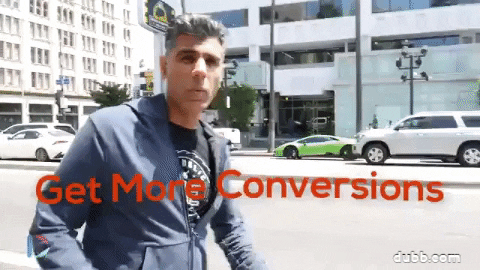
Customize Your Video Emails
Finally, I want to spend a few moments talking about customization. Customization is a really important part of creating any type of video content. After all, your recipients are consuming all kinds of content every day. For the most part, that content is more generalized and isn’t specifically created for them. That content may be extremely valuable, but it doesn’t have a personal touch.
Because of this, you can really distinguish yourself if you create video content that is catered solely to your specific audience. If you create a video email just for a specific audience member or group of audience members, they will be much more likely to watch that video and further engage with your company.
So why doesn’t everyone create hyper-customized videos for their audiences? As you can guess, the main variable is time. Net net, creating a customized video takes somewhat longer than creating a more generic video.
There is a fine line here that you’ll have to navigate. You’ll need to consider both your time constraints and the need to create more customized video emails for your audience.
With that said, I think that there are several principles you can follow here. First, the smaller the potential audience for your video email, the more that you will want to customize your video. If you are sending a one-to-one video email, for example, you will definitely want to include at least some customization in it. At the very least, you can include the recipient’s name. To go one step further, you can address some of the wants, needs, problems, and issues that the recipient is facing in their life. Even if it is just a 30-second video, adding some customization will make your video emails that much more engaging.
If you are looking for an easy way to add more customization at scale, check out Dubb. Dubb helps you leverage more customization in your video emails. From easily adding personalization text to being able to quickly shoot videos and send them to individual audience members, our software makes it much easier to create customized video emails.
Even if you don’t use Dubb, think about how you can make your video emails more tailored to your audiences. From the content that you actually discuss in your videos to little features like personalization text, spending time on customization can really make your video emails shine.
How to Send Video Emails with Dubb
Those are just some of the first principles that you can (and arguably should) rely on when creating any type of video email. As a reminder, you’re going to want to experiment. Keep releasing video emails to your audience and follow the feedback and data that you obtain. Doing this creates a flywheel effect. The more video emails you create, the better they will be.
Getting beyond first principles, however, let’s discuss how you can send video emails using Dubb. Like I said, there are other tools out there that can help you create and send video emails. Even though I am biased, I believe that Dubb offers the easiest and best way to leverage video emails in your work. If you have any questions about what is discussed below, I highly encourage you to contact us.
Getting Started with Dubb
To get started with Dubb, you need to create a Dubb account. It is free and extremely easy to do. Simply click click here to get started. To follow the next steps, you will also need to install the Dubb Chrome Extension (you can do so by clicking here) or the Dubb Outlook add-on (which you can find here). To reiterate, you can get started with all of these tools for free.
How to Send Video Emails with Gmail
Let’s begin by discussing how you can use Dubb to send video emails via Gmail. Normally, when you are sending a video through Gmail, Google will automatically create a Google Drive link to your video. That way, you don’t need to attach your video to the email itself. It avoids some of the email attachment problems that I mentioned above.
While this solution works, Dubb offers an alternative solution. When using Dubb to send a video email via Gmail, you will click on “Compose” as you normally would. When you do so, however, you will see that there is a small Dubb icon that is located in the bottom menu. Clicking on that launches the Dubb interface.
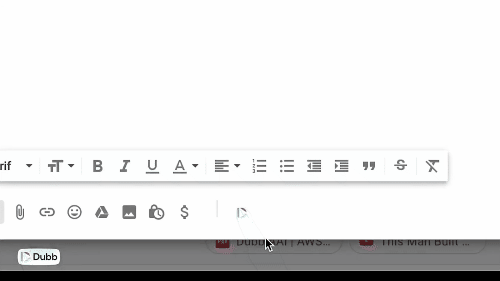
At this point, you have a wealth of options at your fingertips. You can do things like record a video email from your computer’s webcam, upload an already-recorded video to Dubb, or select from videos that you have already created using Dubb. Once you have recorded or selected the video that you want to include in your video email, you will automatically get an animated GIF of your video. That animated GIF is around three to five seconds long and goes a long way in convincing your recipients to watch your video. Along with this, Dubb lets you include personalization text above the animated GIF. Like I said above, this is a great way to customize your videos and continue to build strong relationships with your audience.
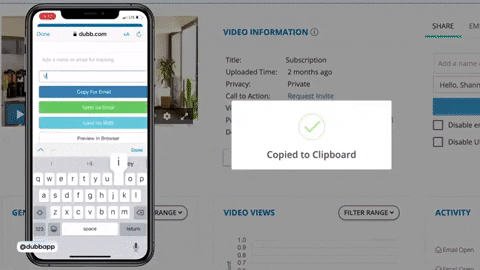
You get these same features if you are creating a video email on the Dubb mobile app. You can find the Dubb mobile app for iOS by clicking here and Android by clicking here. Whether you are recording a new video on the Dubb mobile app or want to send a video that you have already recorded, you get the animated GIF preview and personalization text for all of your videos.
How to Send Video Emails Using Outlook
There is a similar process to sending a Dubb video email through Outlook. Again, you will need to have a Dubb account. However, instead of needing the Dubb Chrome extension, you will need to get the Dubb Outlook add-on.
Once you have done that, you will follow the same process. You will create a new video or upload an already-created video to Dubb. Once you do that, you automatically get access to the three to five-second animated GIF. You also have the option to include personalization text (which you arguably should).
How to Send Video Emails Using Another Email Application
If you don’t use Gmail or Outlook to send your emails, you can still use Dubb to send your video emails. All you need to do is log in at dubb.com and access your dashboard. If you haven’t already, you must upload the video that you want to send in a video email (or record it from there).
Then, all you need to do is click on the video that you want to send. You do this by clicking on the blue button that says “Share & Send.” You will then see several tabs appear on top of the pop-up window. Click on “Copy for Email” and add any personalization text that you’d like.

Finally, navigate to your favorite email platform and paste the GIF preview that links to your Dubb action page.
Using Dubb Action Pages
Whether you are creating a video email using Gmail, Outlook, or something else, you get access to your very own Dubb action page. As a reminder, action pages like the Dubb action page are extremely important tools to help you reach your business goals. Whether you are sending a video email to one person or to many people, you’ll definitely want to take advantage of them.
Like I mentioned above, that Dubb action page can be customized in virtually any way you want. You can include your company’s logo, font, and colors. You can include your contact information (or a colleague’s contact information) at the bottom. Your video is prominently displayed at the top of the page, making it clear that your audience should watch the video.
Critically, you can also take advantage of many CTAs. Some of the CTAs that you can use with Dubb include the following:
- Download a White Paper or eBook: This is a great CTA for viewers who are at the top of your sales funnel. Whether the white paper discusses your service or your company as a whole, it can be a great introduction. It can show your viewer how you can provide immense value in his or her life.
- Communicate via Facebook Messenger: Some of your audience members may not want to further communicate over email. If they are constantly on Facebook, for instance, they can choose this CTA, which lets them interact with your company via Facebook Messenger.
- Send a Video Reply: Video replies can be extremely valuable—for both you and your recipients. For your recipients, video replies are a very easy way to interact with your video content. Instead of typing a lengthy email, they can shoot a quick video reply of their own. As for your company, video replies can be great ways to get video testimonials, which you can then use in your future marketing material.
- Visit Another Page: Dubb lets you include any hyperlink as your CTA. Whether you want your viewer to visit your Instagram page or some other page, you are free to do so.
- Schedule a Call On Your Calendar: Scheduling follow-up calls can be annoying. You need to find mutually agreeable times on your calendars. With this CTA, however, your viewer can easily find an available time on your calendar and book a follow-up meeting with you.
- Purchase Your Product or Service: Finally, this is one of the most exciting CTAs. Using Dubb, you can include a CTA button that leads your viewer to a purchase page. This is especially useful for those prospects that are lower in your sales funnels, but you may be surprised at who makes a purchase immediately after watching your video.
These CTAs can be huge assets as you are looking to monetize your video emails. Even if your goal is to just build a stronger relationship with your audience, these CTAs will make your job much easier.
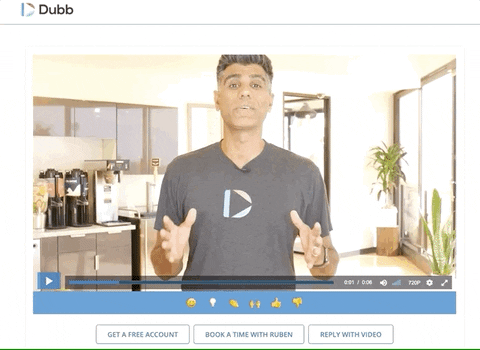
Using Dubb Analytics
Finally, Dubb presents you with some granular real-time analytics. This data shows not only how many people have watched your video, but how long they have watched your video. Just looking at this high-level data can provide you with much more detail about how your videos are performing.
As just one example, if you are noticing that one particular type of video email is leading to longer watch rates, you will want to dig in and find out why. It may be because your audience is interested in the specific topic. It could be something entirely different. With that starting point, however, you’ll be able to create video emails that are even more relevant to your audience.
Even better, Dubb gives you the ability to look at granular data about particular prospects or prospects. For instance, you may notice that a particular prospect is watching many of your videos on a particular topic or subject. Clearly, this is a signal that they may be interested in learning more. With that information in mind, you can schedule a follow-up call with that viewer and make that follow-up call more tailored to their interests and passions.
There are plenty of different ways that you can use Dubb’s detailed analytics. At the bare minimum, however, you should at least take a look at the analytics that Dubb offers you. They’ll provide you with a wealth of insights that you can then use to create more effective video emails.
Get Started Today
A video email may seem like a simple thing on the surface. It’s just a traditional email with a video link in it, right?
I hope that at this point, you can see that it is much more than that. A video email can be just the thing to help you build stronger relationships with your audience. It can make an individual audience member feel like your company is more than just a monolithic entity. Better yet, it can be just the thing that you need to reach your sales goals.
So if you are just coming across video emails for the first time, I recommend that you give them a try. Try recording one—even if it is just for a colleague. You will soon discover that video emails are outstanding ways to communicate with almost anyone.
And if you have already created video emails? I encourage you to use the first principles discussed above to create even better video emails. This is truly a practice so you need to put in the work to see the best results.
Finally, I encourage you to check out Dubb. We offer plenty of tools for all types of creators to send outstanding video emails. To learn more about Dubb and how we can help you, click here. You can also click here for a free seven-day trial for our premium plans.

